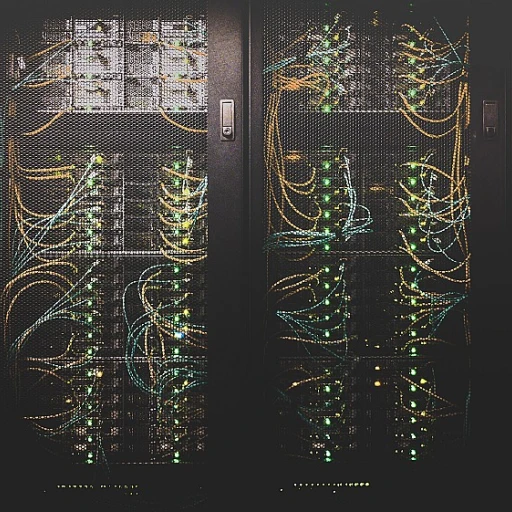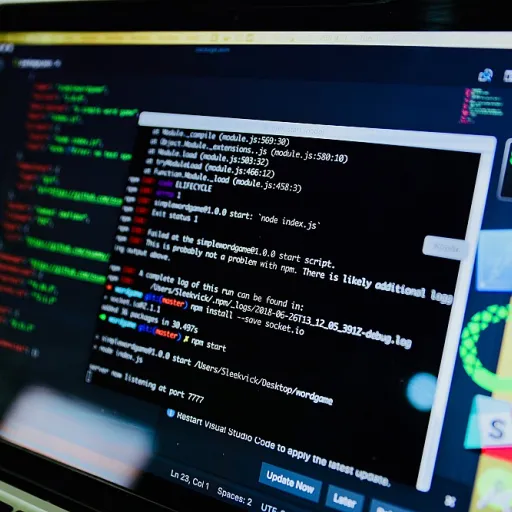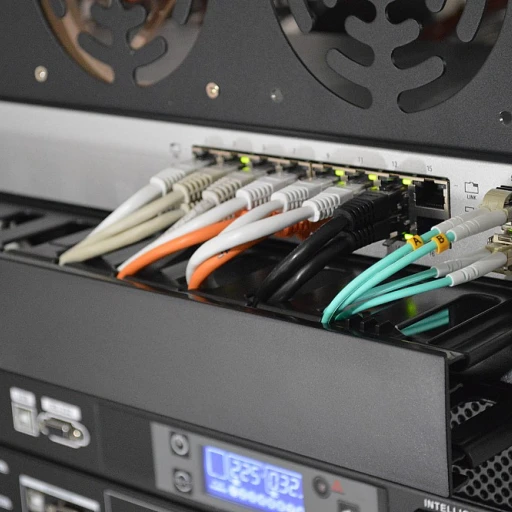
The Current Landscape of Office Management Software
Understanding the Current Software Landscape
In today's fast-paced business environment, office management software has become an indispensable tool for organizations striving to enhance productivity and streamline operations. The current landscape is dominated by a variety of platforms that cater to different aspects of office management, from project management to communication and collaboration.
Software tools like Microsoft Teams and Google Workspace have revolutionized how teams communicate and collaborate in real time. These platforms offer a suite of features that facilitate seamless interaction among team members, whether they are in the same office or working remotely. The integration of tools such as Google Drive and Google Calendar into these platforms further enhances their utility, making them essential for workplace management.
Key Features Driving Adoption
The adoption of office management software is largely driven by its ability to improve productivity and efficiency. Key features such as task automation, data management, and event management are crucial for office managers looking to optimize their workflows. Additionally, the availability of free versions of these tools helps smaller teams and startups to leverage their benefits without significant financial investment.
Project management tools like Slack and Asana offer robust solutions for managing projects and tracking progress. These tools help teams stay organized and ensure that projects are completed on time, enhancing overall productivity.
Challenges and Opportunities
While the current landscape offers numerous advantages, it also presents challenges that organizations must navigate. Implementing new software solutions can be complex, requiring careful planning and consideration of user experience and security concerns. As we explore emerging technologies and future trends, it is essential to evaluate the efficiency of existing structures and adapt to the evolving needs of the workplace.
For more insights into evaluating the efficiency of current systems, you can explore this resource.
Emerging Technologies Shaping Office Management
Technological Innovations Transforming Office Management
The landscape of office management is rapidly evolving, driven by emerging technologies that promise to enhance productivity and streamline operations. As businesses strive to optimize their workflows, several key innovations are shaping the future of office management software.
Artificial Intelligence and Machine Learning
Artificial intelligence (AI) and machine learning (ML) are at the forefront of this transformation. These technologies enable office management tools to automate routine tasks, such as scheduling meetings or managing emails, thereby freeing up time for more strategic activities. AI-powered features in platforms like Microsoft Teams and Google Workspace enhance collaboration by providing real-time insights and suggestions, improving decision-making processes.
Cloud-Based Solutions
Cloud technology is another game-changer, offering flexibility and scalability that traditional on-premise solutions cannot match. Cloud-based office management software allows teams to access tools and data from anywhere, facilitating remote work and enhancing productivity. Solutions like Google Drive and Slack exemplify how cloud platforms support seamless communication and collaboration across dispersed teams.
Integration and Interoperability
Integration capabilities are becoming increasingly important as organizations seek to create cohesive digital ecosystems. Modern office management tools are designed to integrate with a wide range of applications, from project management software to event management platforms. This interoperability ensures that data flows smoothly across different systems, enhancing efficiency and reducing the risk of errors.
Data-Driven Decision Making
Data management and analytics are crucial for informed decision-making. Advanced office management software tools now offer robust analytics features, enabling office managers to track key performance indicators and optimize operations. By leveraging data, organizations can make strategic decisions that drive growth and improve workplace management.
For a deeper understanding of how these technologies are shaping the future of software, explore our insights on effective GTM strategies for data enrichment platforms.
Challenges in Implementing New Software Solutions
Overcoming Barriers to New Software Integration
Implementing new office management software can be a daunting task for many organizations. While the promise of enhanced productivity and streamlined operations is appealing, the transition often comes with its own set of challenges. Understanding these obstacles is crucial for a successful integration.
One of the primary hurdles is the resistance to change. Employees accustomed to existing systems may find it difficult to adapt to new tools. This is particularly true for teams that have been using traditional management tools for years. To mitigate this, it’s essential to involve team members early in the decision-making process, ensuring they feel part of the transition rather than subject to it.
Another significant challenge is the compatibility of new software with existing systems. Many offices rely on a mix of platforms like Microsoft Teams, Google Workspace, and Slack for communication and collaboration. Ensuring that the new software integrates seamlessly with these tools is vital to avoid disruptions in workflow. For instance, a platform that supports integration with Google Drive and Google Calendar can significantly enhance productivity by centralizing data management and scheduling tasks.
Cost is another factor that can hinder the adoption of new management software. While some tools offer free versions, these often come with limited features that may not meet the needs of a growing office. Budget constraints can make it challenging to invest in comprehensive solutions that offer real-time project management and workplace management capabilities.
Training and support are also critical components of successful software implementation. Without adequate training, even the most intuitive tools can become a source of frustration rather than a productivity booster. Providing ongoing support and resources can help teams navigate the new system more effectively, ensuring that the software becomes an asset rather than a burden.
Lastly, data security and privacy concerns cannot be overlooked. As offices increasingly rely on digital tools for event management and travel management, safeguarding sensitive information becomes paramount. Ensuring that the chosen software complies with industry standards and offers robust security features is essential to protect both the organization and its clients.
The Role of User Experience in Software Adoption
The Importance of User-Centric Design in Software Tools
In the rapidly evolving landscape of office management software, the role of user experience (UX) is more critical than ever. As businesses increasingly rely on digital tools to streamline operations, the ease with which team members can navigate these platforms directly impacts productivity and collaboration. Whether it's a project management tool like Microsoft Teams or a communication platform such as Slack, the user interface must be intuitive and efficient.
Office managers and teams often juggle multiple tasks, from event management to data management. Therefore, software tools that offer a seamless user experience can significantly enhance workplace productivity. For instance, integrating tools like Google Workspace and Google Calendar into daily workflows allows for real-time collaboration and efficient time management. These features help teams stay organized and focused on their projects.
Balancing Functionality with Simplicity
While advanced features are essential, they should not come at the expense of usability. A management tool packed with functionalities might seem appealing, but if it's too complex, it can hinder rather than help. The key is to balance functionality with simplicity, ensuring that even free tools are accessible to all team members, regardless of their technical expertise.
Moreover, as discussed in the section on emerging technologies, the integration of AI and machine learning into office management software can further enhance user experience by providing personalized insights and automating routine tasks. However, these advancements must be implemented thoughtfully to avoid overwhelming users with unnecessary complexity.
Feedback and Continuous Improvement
To ensure that software tools remain user-friendly, continuous feedback from users is vital. Regular updates based on user input can help developers refine the platform, addressing any pain points and enhancing overall satisfaction. This iterative process not only improves the tool but also fosters a sense of ownership among users, encouraging them to fully engage with the software.
In conclusion, as the future of office management software unfolds, prioritizing user experience will be crucial. By focusing on intuitive design, balancing functionality with simplicity, and incorporating user feedback, software developers can create tools that truly support workplace efficiency and collaboration.
Security and Privacy Concerns in Office Management Software
Addressing Security and Privacy in Office Management Software
In today's digital age, the security and privacy of office management software are paramount. As organizations increasingly rely on digital tools to streamline operations, the potential risks associated with data breaches and unauthorized access have grown. This concern is particularly relevant for platforms like Google Workspace and Microsoft Teams, which are integral to many workplaces.
One of the primary challenges is ensuring that sensitive data, such as project details and team communications, remain secure. Many management tools now incorporate advanced encryption methods to protect data both in transit and at rest. However, the effectiveness of these measures depends on the consistent application of security protocols by all team members.
Balancing Accessibility with Security
While security is crucial, it must be balanced with the need for accessibility. Office managers and team members require easy access to management software to maintain productivity and collaboration. Tools like Slack and Google Drive offer features that facilitate real-time communication and data sharing, but they must also implement robust authentication processes to prevent unauthorized access.
Multi-factor authentication (MFA) is becoming a standard feature in many platforms, providing an additional layer of security. By requiring users to verify their identity through multiple channels, MFA helps protect against unauthorized logins and potential data breaches.
Privacy Concerns in Workplace Management
Beyond security, privacy is another critical aspect of office management software. Organizations must ensure that their tools comply with data protection regulations, such as GDPR, to safeguard user privacy. This involves transparent data management practices and clear communication with users about how their data is used and stored.
Moreover, as remote work becomes more prevalent, the line between personal and professional data can blur. Management tools must offer features that allow users to control their data and maintain privacy, even when using the same platform for both work and personal tasks.
In conclusion, while office management software offers numerous benefits in terms of productivity and collaboration, it also presents challenges related to security and privacy. By prioritizing these aspects, organizations can ensure that their management tools not only enhance efficiency but also protect their most valuable assets: their data and their people.
Future Trends in Office Management Software
Anticipating the Next Wave of Office Management Software
The future of office management software is poised for significant transformation, driven by rapid technological advancements and evolving workplace dynamics. As organizations continue to adapt to hybrid work models, the demand for more sophisticated and integrated management tools is on the rise.
One of the key trends is the increased integration of artificial intelligence and machine learning into office management platforms. These technologies are expected to enhance productivity by automating routine tasks, offering predictive analytics, and providing personalized user experiences. For instance, AI-driven project management tools can help teams allocate resources more efficiently and predict project timelines with greater accuracy.
Another trend is the growing emphasis on collaboration and communication tools. As remote work becomes more prevalent, platforms like Microsoft Teams and Slack are evolving to offer more comprehensive solutions that integrate seamlessly with other productivity software. These tools help facilitate real-time communication and collaboration, ensuring that team members remain connected regardless of their physical location.
Moreover, the integration of cloud-based solutions such as Google Workspace and Google Drive is becoming increasingly important. These platforms provide flexible and scalable solutions that support the diverse needs of modern workplaces, from document management to event management and beyond.
Security and privacy will continue to be paramount as organizations adopt new technologies. Future office management software will likely feature enhanced security measures to protect sensitive data and ensure compliance with evolving regulations.
Finally, the focus on user experience will remain a critical factor in software adoption. As discussed earlier, intuitive interfaces and customizable features will be essential in ensuring that office managers and team members can effectively utilize these tools to enhance productivity and streamline operations.
In conclusion, the future of office management software is bright, with numerous opportunities for innovation and growth. As technology continues to evolve, organizations must stay informed and agile to leverage these advancements effectively.





-large-teaser.webp)









